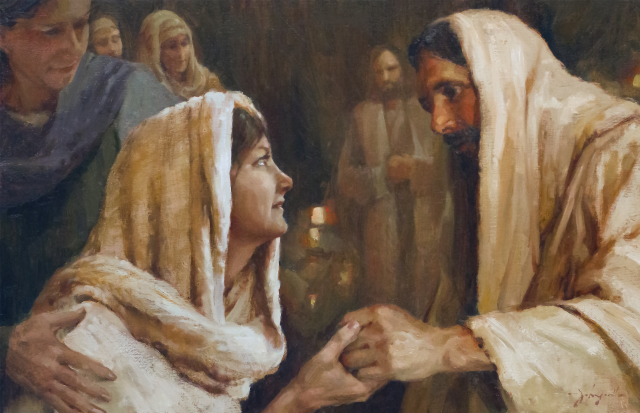Lent has an important role for Christians. We have an opportunity to reflect on the past year, what went well and what didn’t, and what needs action, work, attention, etc. Lent as a church season provides an invitation to return to God, to amend our lives, and to give thanks for this season of grace and repentance. Lent offers a vital opportunity to restore ourselves to spiritual wholeness.
And so, as we head to the beginning of Lent on February 17th, this Sunday’s Gospel passage gives us some excellent insights into Jesus’ actions of healing. He brings those he meets back to health, wholeness, and to their roles in society, through healings and exorcisms.
In our gospel reading for this Sunday, we learn several key insights that help us understand the need for Jesus’ healing balm. Before reading the Gospel of Mark, keep in mind a few important themes that run through it.
- Jesus understood the importance of living within one’s social station. Honor was hard won, but it could be lost in an instant. This is likely why Jesus consistently silenced the demons and unclean spirits from identifying Jesus to the crowd in Mark. To encounter such a great healer would have seemed beyond the pale of possibility for those witnesses. After all, Jesus was the son of a carpenter from a little village called Nazareth (read “backwoods”). Jesus seemed content to let his actions speak for him and let the people draw their own conclusions.
- The Gospel of Mark is about action. In the first chapter alone, the writer of Mark uses “immediately” 8 times to highlight how Jesus acted quickly by preaching, healing, and casting out demons with efficiency. In Mark, Jesus teaches by immediate action. Mark oftens gives us the time of day in “double phrases” like “That evening, at sundown” to further underscore the quickness of his response to a problem.
- Jesus was a pious Jew although we as 21st Christians often think of him as a Christian. Devout Jewish men prayed in the early morning. Likewise, Jesus, in practicing what we could legitimately call a spirituality of resistance, fueled his ministry — his action — through prayer. He, too, battled injustice, cruelty, and lack of compassion by taking up the cause of those struggling to survive in Roman-occupied Israel. He even reached out to Gentiles and the “others” of first century Palestine.
- Jesus gained a reputation as a Holy Man, one of power and authority. His miraculous deeds authenticated his preaching and teaching.
I’ve italicized words and phrases that fit the descriptions above to aid in reflecting on the lessons we can take from this story.
Jesus Heals Many at Simon’s House (Mark 1:29-39, RSV)
29 And immediately he left the synagogue, and entered the house of Simon and Andrew, with James and John. 30 Now Simon’s mother-in-law lay sick with a fever, and immediately they told him of her. 31 And he came and took her by the hand and lifted her up, and the fever left her; and she served them.
32 That evening, at sundown, they brought to him all who were sick or possessed with demons. 33 And the whole city was gathered together about the door. 34 And he healed many who were sick with various diseases, and cast out many demons; and he would not permit the demons to speak, because they knew him.
A Preaching Tour in Galilee
35 And in the morning, a great while before day, he rose and went out to a lonely place, and there he prayed. 36 And Simon and those who were with him pursued him, 37 and they found him and said to him, “Every one is searching for you.” 38 And he said to them, “Let us go on to the next towns, that I may preach there also; for that is why I came out.” 39 And he went throughout all Galilee, preaching in their synagogues and casting out demons.
Do these demons or unclean spirits relate to our time?
Without a doubt in my mind, yes, they do. When we, living in the 21st century, think of demonic possession, many may automatically think of the movies The Exorcist or The Omen, etc. My advice is, “Don’t go there.” These are 20th century works of fiction, possibly based in part on fact, and possibly based in part on tradition. But allowing this framework to dictate our comparisons and understandings merely cheapens this rich text.
Instead of allowing these art forms to frame our interpretation, let’s stay with Jesus in his world for a while longer before we apply Jesus’ teaching by way of action in our time.
Besides being physically sick in body, or having an organic malady of the brain, I believe that what affects us most powerfully is the lack of spiritual health and vitality. I believe this because of the teachings and actions of Jesus and also from the writings of the Christian mystics.
Spiritual health restored through healing
If I step into the role of Peter’s mother-in-law, my experience with Jesus would unfold something like this. I’d be ill and on my bed, and my son-in-law would bring Jesus to me upon his arrival. He would assess my situation tenderly and with compassion. Jesus would touch my hand to pass his healing power, warmth, and concern to my ailing body to drive the infirmity out of my body and worry from my mind. And finally, with gentleness, Jesus would raise me up from my sickbed.
Restored to health and wholeness, I would return to my role to serve and minister to Jesus and the disciples, perhaps all of the household. Jesus prized service, and he stated many times that he came into the world, not to be served, but to serve.
Jesus silences our demons and calls them out of us
The healing/exorcism story follows an identifiable pattern in Mark.
- First Jesus meets the demon where it is located — both at a place and in a person (I will use demon interchangeably with unclean spirit in this discussion).
- The demon tries to resist Jesus’ power.
- Jesus responds with overwhelming power, usually by silencing the demon.
- Jesus commands the demon to depart the person.
- The demon leaves per Jesus’ command.
- The witnesses respond with awe, wonder, amazement, and usually the story spreads despite Jesus’ instruction to them to keep quiet.
The Greco-Roman people of Jesus’ time understood the universe to be composed of many spirits, most of which were threatening. Actually, the people thought that humanity made up just a small part of their whole world. These ancient societies often focused on the release from bad spirits to be able to live their best lives according to their social stations in life.
This context provides vital understanding about why the gospel writers had concern for possessions by demons (in the Greek world) and unclean spirits (in the Jewish world).
If we are uncomfortable with terms like demon, unclean spirit, or possession, let us look to how an “illness” presents itself instead. If we are sick, addicted, troubled, mentally ill, feel spiritually dry, or have lost the meaning of life, we can aptly refer to these conditions as illnesses, in general. They cause us to lose a sense of wholeness, of health, and well-being. Because of these states of being, we often cannot fully function in our life’s roles of parent, child, neighbor, worker, friend, etc.
Today, we have many more nuanced terms for the things that ail us because the first century peoples lacked our science and understanding, but that does not mean they were wrong. It means they defined life’s encounters according to their understanding in that snapshot in time. And while they would benefit from our knowledge, we would do well to retain their sensitivity to spiritual health. Since the Enlightenment, many Western societies have gradually shoved spiritual matters to the back burner in favor of our belief in our own autonomy.
So while saying,” I have a demon,” sounds archaic, if not a bit weird, we do understand that things have the power to possess us and hold us captive. We often call this suffering rather than possession. I do believe that matters of the mind and heart can take hold of us, captivate us, and even hold us hostage.
So now let’s return to present day. Admittedly, I have been somewhat obsessed with bad thoughts and feelings since the storming of the US Capitol on January 6th. I have harbored some uncharitable attitudes towards the folks doing the storming. I’m trying to stop this unhealthy spiritual attachment in blaming them and, frankly, thinking they are too stupid to reject crazy conspiracy theories of the QAnon ilk.
I’ve brought this concern to Jesus in prayer and asked him to silence these terrible ideas that work to overtake my waking moments. I have prayed that he will silence them and draw them out from me. I also pray that Jesus will raise me up to continue my mission as a political theologian. Despite the temptation to demonize such people, I want to repurpose that energy into action, just as Jesus did. Instead of just getting angry, Jesus worked against the forces of evil and distraction. It would be easier to just sit on my sofa and fume about everything. But that in no way contributes plausible solutions to these profound issues.
I’ve called on Jesus to silence or to help me silence these thoughts. And, as these feelings diminish, I must submit to their becoming silent and departing. I can’t waste energy trying to reconjure them. I have to move on, just as we all must move on in favor of positive action. Having done so, I am feeling the gradual release of this possession — being held captive by judgmental hatred.
And so, as we continue our reflection on the spirituality of resistance, here is some homework for you to finish before Ash Wednesday, February 17th:
Identify 3 things that you feel are holding you captive. In prayer, begin turning them over to Christ in whatever way works best for you. What will we cast out this Lent?
Next week, we will be looking at the Transfiguration of Jesus with Moses and Elijah, as Peter, James and John look on. We’ll explore what our transfigurations might look like during this Lenten season of returning to God.
Blessings on your journey.+






2 thoughts on “The Spirituality of #Resistance: Our Need for Healing”
Dear Marcia,
Your discussion is very thoughtfully written. When I think of the mother-in-law’s illness, I think of perhaps a terrible headache that disables, or depression, that also disables. In touching her, Jesus allows her to shed this disability, this heavy weight, and lifts her up, the headache gone miraculously into a lighthearted joy, and she is immediately able to function and display the joyful ability to serve as hostess, to display hospitality and a joyful reciprocity for being healed. The negative to positive with immediacy.
In terms of demons, when we think of people who believe in conspiracy theories, what often inspires their beliefs is fear, abject fear, however irrational. That is demonic, being overcome by a demon they cannot shed. It reminds me of the scene in Mark of the possessed pigs running into the sea for self destruction, which I suppose demonic possession results in. If you cannot be healed, you self destruct, or you destroy others. That isn’t dealt with in the Bible. But it exemplifies how fearful these people were of demon possession. So Mary Magdalene was cured of 7 demons, which must have left her in an awful state and explains her abject discipleship of Jesus after being cured.
Perhaps we could start from a feeling of sympathy toward those in our modern day who are demon possessed, esp because we do not understand them. We think they are evil, and, in being possessed, they are. How to rid them of their fears and their being possessed? That will be the miracle to pray for.
Dear Astrid,
Thank you for your kind words and insights into this vital passage. I really like how you phrased the healing and aftermath as “the negative to positive with immediacy. I think you’re right, too, that we must not demonize when we don’t understand someone, or what is going on with them. That’s a tall order sometimes but it’s what Christ calls us to do. Whenever possible, Jesus asked, “What do you need, how can I help?” This is our blueprint for engaging with others we don’t like, understand, or fear.
Comments are closed.